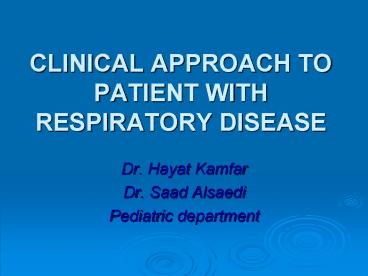CLINICAL APPROACH TO PATIENT WITH RESPIRATORY DISEASE - PowerPoint PPT Presentation
1 / 22
Title:
CLINICAL APPROACH TO PATIENT WITH RESPIRATORY DISEASE
Description:
CLINICAL APPROACH TO PATIENT WITH RESPIRATORY DISEASE Dr. Hayat Kamfar Dr. Saad Alsaedi Pediatric department Continue .symptom Hemoptysis (coughing bloody sputum ... – PowerPoint PPT presentation
Number of Views:539
Avg rating:3.0/5.0
Title: CLINICAL APPROACH TO PATIENT WITH RESPIRATORY DISEASE
1
CLINICAL APPROACH TO PATIENT WITH RESPIRATORY
DISEASE
- Dr. Hayat Kamfar
- Dr. Saad Alsaedi
- Pediatric department
2
- Learning Objectives
- Student will be able to recognize and describe
- The common symptoms of pulmonary diseases and
significant characteristics to identify n the
review - The characteristics of the 4 types of normal
breath sounds ( tracheal, bronchial,
broncho-vesicular and vesicular) - The appropriate terms for describing normal and
abnormal lung sounds
3
- Continueobjective.
- Appropriate history taking /physical examination
of the respiratory system and interpret symptoms
with the signs - Common causes for abnormalities identified during
physical examination of patient with respiratory
diseases - The value of other assessment adjuncts e.g. chest
x-ray, PFM and ABG
4
- Common Symptoms
- cough
- voluntary or involuntary, timing, chronicity and
nature, type, characteristic - breathlessness( dyspnoea)
- onset, nature, associations
- Wheeze
- types (monophonic, polyphonic)
5
Continue.symptom
- Hemoptysis
- (coughing bloody sputum)
- Sputum production
- Chest pain
- Cyanosis
- fever
6
LUNG SOUNDS??
- Normal and abnormal
7
Normal bronchovesicular sounds
Normal tracheobronchial sounds
Normal vesicular sounds
Fine crackles
Coarse crackles
Ins.crackles,ex.wheeze
Lung consolidation
M.ex.wheeze
8
?? sleepy
Wake-upmore to come
9
HISTORY AND PHYSICAL EXAMINATION
10
The principles of interviewing pulmonary patient
include careful listening and questioning, in
association with skillful observation Initial
and subsequent interviews usually centered around
a discussion of patients chief complaints or
symptoms
11
- Full relevant systematized and careful history
taking that includes - identifying data
- chief complaint and H/O present illness
- systemic review
- past history
- family history
- social, occupational and travel history
- smoking history
12
All health professionals should become expert in
techniques of physical examination Phy. Ex. In
pulmonary patient entails the time-honored
combination of inspection, palpation, percussion
and auscultation of the chest
13
- Inspection
- observe if in pain or distressed
- type of breathing rapid, slow, shallow or deep
and use of accessory muscles - chest and spinal deformities, skin changes,
breast and nutritional status - other areas such as nails, lips for cyanosis and
clubbing and neck JVP and lymph nodes
14
- Palpation
- confirms skeletal abnormalities and areas of
tenderness - can reveal masses, pulsations and areas of
crepitation( subcutaneous emphysema) - transmitted vibration through chest wall
(fremitus) - palpate neck for trachea
15
- Percussion
- determine the appropriate density of the
patients lungs - resulting sounds classified as normal, increased
or decreased resonance
16
- Auscultation
- The act of listening to sounds produced in the
body e.g. by lung sounds - the art of use of stethoscope
- application and skill development conditions
such as quiet room, ICU, and ventilated patient - avoid common errors such as listening to breath
sound through patients gown, auscultating only
the convenient areas
17
Is clinical assessment completed??
18
- Other assessment adjuncts
- chest roentgenogram
- pulmonary function test
- arterial blood gases
- other specific laboratory /or roentgenogram
- surgical diagnostic procedures such as
bronchoscopy and lung biopsy
19
- Some pulmonary diseases or conditions
- infections such as pneumonia and tuberculosis
- bronchial asthma
- chronic bronchitis
- bronchiectasis
- pneumothorax
- emphysema
- pleural effusion
- congestive heart failure
20
(No Transcript)
21
- Summary
- clinical approach of patients with respiratory
diseases requires KSA - K knowledge of basic information of the
respiratory system (anatomy, physiology,
histopathology and biochemistry) - S skills needed for appropriate full careful
medical history and physical examination approach
of patients with respiratory symptom/s - A attitude of learner facilitate highly in
developing and understanding patients with
respiratory complaint
22
THANK YOU

